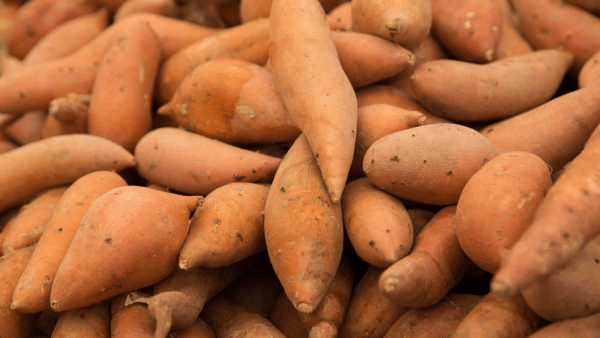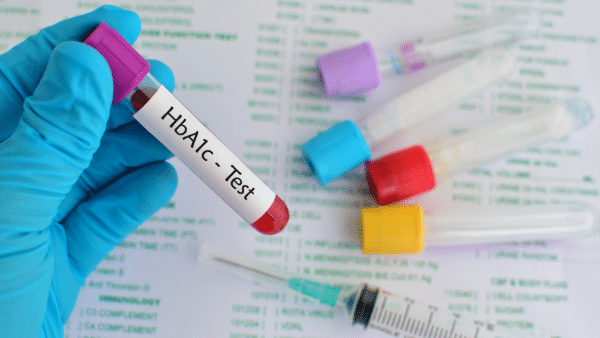Introduction
Ah, sweet potatoes. They’re like the Internet’s darling of the tuber world, having graduated from Thanksgiving dinner sidelines to starring roles in health food conversations across the globe. And why not? They’re sweet, they’re filling, and they can turn into fries. Yes, fries! But here comes the million-dollar question, knocking on our doors like an uninvited guest at a dinner party: Can diabetics indulge in these orange delights without throwing their blood sugar levels into a frenzy?
If you’re picturing yourself in a standoff with a sweet potato, à la Clint Eastwood in a Spaghetti Western, then you’re in the right place. We’re about to dissect this root vegetable mystery with the precision of a seasoned chef, slicing through myths, dicing facts, and serving them up on a silver platter. Buckle up, my friend. It’s going to be a sweet ride.

Understanding Diabetes and Dietary Needs
Now, before we can answer the sweet potato conundrum, we’ve got to do a little detective work on diabetes itself. Imagine diabetes as that one relative we all have who’s a bit hard to predict. Sometimes they’re all cool and collected, and other times, well, they throw a curveball that has everyone scrambling. In the world of health, diabetes plays by its own rules, impacting how your body processes food for energy.
Here’s the deal: When we eat, our bodies break food down into glucose. Think of glucose as the fuel that powers your body’s engine. But to get this fuel into the engine (your cells), you need a key, and that key is insulin. For folks with diabetes, the key doesn’t always fit. This means glucose can’t get where it needs to go, leaving blood sugar levels as unpredictable as a cat on a hot tin roof.
Now, enter the world of managing diabetes, where counting carbs isn’t just a pastime; it’s a way of life. Because not all carbs are created equal, much like not all YouTube comments are helpful. Some carbs cause your blood sugar to spike faster than a rocket, while others let it rise gently, like a well-mannered guest at a dinner party. That’s where the glycemic index comes into play, ranking carbs on how drastically they affect your blood sugar. And guess what? Our friend, the sweet potato, has a tale to tell in this narrative.
So, let’s keep our detective hats on and dive deeper into the case of sweet potatoes. Are they the hero we’ve been waiting for, or is this another case of too good to be true? Stay tuned.

The Nutritional Profile of Sweet Potatoes
Imagine if superheroes were vegetables. In that universe, sweet potatoes would be wearing capes and flying around, saving the day with their nutritional powers. But what exactly makes these orange tubers worthy of a superhero status? Let’s dive into their secret identity, shall we?
First off, sweet potatoes are packed with complex carbohydrates. But don’t let the word “carbohydrates” scare you off—they’re the good kind, the kind that gives you energy without spiking your blood sugar faster than a teenager’s mood swings. Plus, they’re loaded with fiber, which is like the body’s broom—it sweeps through your digestive system, keeping things clean and tidy.
But wait, there’s more! Sweet potatoes are a treasure trove of vitamins and minerals. They’ve got vitamin A in spades, enough to make carrots jealous. They’re also rich in vitamin C, manganese, and several other nutrients that play vital roles in your body, like a well-rehearsed orchestra creating a symphony of health.
Now, you might be thinking, “All this sounds great, but what about the sugar?” Ah, my inquisitive friend, sweet potatoes do have natural sugars, but their high fiber content acts like a buffer, slowing down the absorption of sugar into your bloodstream. It’s like having a responsible friend who makes sure you get home safely after a wild night out.
Table: Sweet Potato vs. Other Potatoes – A Nutritional Showdown
| Nutrient | Sweet Potato (100g) | White Potato (100g) |
|---|---|---|
| Carbohydrates | 20g | 17g |
| Sugars | 4.2g | 0.8g |
| Fiber | 3g | 2.2g |
| Glycemic Index | Medium | High |
As you can see, sweet potatoes hold their ground pretty well in the nutrition department. But does this mean they’re a green light for diabetics? Let’s not jump to conclusions faster than a cat on a hot tin roof—there’s more to the story.

Sweet Potato Fries and Diabetes
Ah, sweet potato fries. Who doesn’t love a good fry? They’ve strutted into the culinary scene with all the confidence of a peacock, flaunting their orange hue as a badge of health honor. But here’s the million-dollar question: are sweet potato fries the sidekick diabetics have been waiting for, or is this another villain in disguise?
Let’s break it down, detective-style. Frying, the cooking method that can turn a kitchen newbie into a crispy snack maestro, has its pitfalls. Yes, even when our beloved sweet potatoes are the star. You see, when we take something as wholesome as a sweet potato and introduce it to the sizzling world of oil, things get complicated. The act of frying can add extra calories and potentially unwanted fats, turning our health hero into a bit of a mixed bag.
But before you toss out your fryer and swear off sweet potatoes in despair, let’s look at the silver lining. It’s all about the method. Baking sweet potato fries instead of deep-frying can keep the nutritional integrity intact, like a knight protecting its castle. You get the crispy texture without the extra baggage. It’s like choosing a superhero sidekick who can actually keep up.
So, if you’re eyeing those sweet potato fries with a mix of desire and suspicion, remember: moderation is your ally, and baking is your secret weapon. As with any good thing in life, the key is not to go overboard. Treat sweet potato fries like that catchy song on the radio—enjoy it, but maybe don’t put it on repeat all day.
Now, as we navigate through this culinary journey, there’s a beacon of guidance that can’t be ignored: blood sugar monitoring. Let’s shift gears and talk about why keeping an eye on your blood sugar is like having a map in the wild world of diabetes management.
The Role of Blood Sugar Monitoring in Diabetes Management
Now, let’s talk about a pivotal scene in our diabetes management blockbuster: blood sugar monitoring. It’s the plot twist that can turn a seemingly dire situation into a triumphant victory. Think of it as your personal diabetes GPS, guiding you through the rocky terrain of blood sugar highs and lows.
Monitoring your blood sugar is akin to being the captain of your ship in the vast ocean of diabetes management. Some days, the sea is calm, and navigating is a breeze. Other days, you’re facing a storm, dodging lightning bolts of unexpected glucose spikes. But with a trusty glucose meter by your side, you’re never truly lost at sea. This little device helps you make informed decisions, like whether it’s a good day to sail towards the island of Sweet Potato Fries or if it’s better to anchor away.
Regular blood sugar checks are like checkpoints in a video game; they show you how well you’re playing the game of diabetes control. Eat something new, like our friend the sweet potato, and your meter gives you instant feedback. It’s like having a secret conversation with your body, where it tells you, “Yep, that worked!” or “Whoa, buddy, let’s not do that again.”
But here’s the real magic: over time, these checkpoints help you map out a personalized diabetes management plan. They reveal patterns, like how your blood sugar responds to certain foods, exercise, and even stress. It’s like crafting a tailor-made suit; it fits you perfectly because it’s designed with your unique measurements.
So, why is blood sugar monitoring as critical as the climax in a hero’s journey? Because knowledge is power. The more you know about how different foods and activities affect your blood sugar, the better equipped you are to manage your diabetes and keep complications at bay. It’s about taking control of your narrative and steering your story towards a happier, healthier ending.

Best Practices for Diabetics Eating Sweet Potatoes
Picture this: sweet potatoes have passed the audition. They’ve got talent, nutritional benefits, and they’re ready for their close-up in your diabetic diet. But how do we ensure they don’t turn into a diva, demanding too much of your daily carb allowance and throwing your blood sugar out of whack? Here’s the director’s cut on making sweet potatoes work for you, not against you.
Start Small
When it comes to sweet potatoes, think of them as a potent spice. A little goes a long way. Start with small portions—about half a cup of cooked sweet potato is a good benchmark. It’s like adding a pinch of salt to your meal; you can always add more, but you can’t take it away once it’s there.
Timing is Everything
Timing your sweet potato intake can be as crucial as the timing of a comedian’s punchline. Incorporating them into your meal plan when your blood sugar is typically more stable might be a smarter choice. For many, this could be during the day or after some physical activity, when your body is more efficient at managing glucose.
The Power of Pairing
Sweet potatoes should never fly solo. Pair them with a source of lean protein or healthy fats to slow down the absorption of glucose into your bloodstream. It’s like having a chaperone at a dance; it keeps everything under control and moving smoothly. A grilled chicken breast or a handful of nuts can be the perfect dance partners for your sweet potatoes, ensuring the music doesn’t get too loud (aka your blood sugar doesn’t spike).
Keep an Eye on the Preparation
Remember our earlier chat about sweet potato fries? The same principle applies to all sweet potato dishes. How you prepare them matters. Baked, boiled, or mashed sweet potatoes with a dash of cinnamon can be delightful without being a drama queen. Avoid the temptation of dousing them in butter or sugar, which can turn a healthy choice into a metabolic nightmare.
Listen to Your Body
Lastly, and most importantly, listen to your body. It’s the lead actor in this play, and its feedback is invaluable. Use blood sugar monitoring to understand how your body responds to sweet potatoes. It’s like getting real-time audience feedback during a live performance. If your body responds well, you’ve got a hit. If not, it might be time for a script revision.

The Significance of Hemoglobin A1c Testing in Managing Diabetes and Diet
Frequent A1C blood tests are your secret weapon? The Hemoglobin A1c test. This isn’t just any routine check-up; it’s a comprehensive report card of your blood sugar levels over the past two to three months. Unlike the daily ups and downs captured by your glucose meter, the HbA1c test shows you the bigger picture, giving you insight into how well you’re controlling your diabetes over time.
Now, you might wonder, how does this tie into your diet? Imagine each food choice you make as a clue in solving this mystery. The HbA1c test helps you see which foods are your allies in disguise and which ones are villains, lurking in the shadows of your meal plan. By understanding the impact of different foods on your long-term blood sugar levels, you can make informed decisions about what to eat, how much, and when.
But the plot thickens. The role of the HbA1c test doesn’t end with just identifying the good guys and the bad guys in your diet. It’s also about adjustments, fine-tuning your meal plan like a detective adjusting their strategy based on new evidence. For instance, if your HbA1c levels are higher than your target, it might be time to reevaluate those sneaky carbs hiding in “healthy” snacks or reconsider the portion sizes of your meals.
Moreover, this test plays a crucial role in your dialogue with healthcare providers. It’s like having a secret code that lets you and your doctor or dietitian devise a personalized nutrition plan that’s more effective in controlling your diabetes. With regular HbA1c testing, you’re not just reacting to blood sugar spikes and dips; you’re anticipating them, planning your meals and snacks with the precision of a master detective laying a trap for an elusive suspect.
In essence, the Hemoglobin A1c test is a powerful tool in your diabetes management arsenal, illuminating the path to better control through diet and lifestyle adjustments. It’s about transforming the mystery of diabetes management into a case you can solve, meal by meal, day by day, with the confidence of a detective closing in on the solution.

Conclusion
In managing diabetes, sweet potatoes emerge as a versatile character. They’re not only nutrient-rich but can also fit into a diabetic diet when approached with mindfulness. Moderation is key—like finding the right balance in a well-composed symphony. The preparation method also plays a crucial role; baked or roasted sweet potatoes can be a healthier choice that doesn’t spike your blood sugar levels. And, like any good detective, keeping an eye on the clues is essential. Regular blood glucose monitoring acts as your magnifying glass, helping you understand how your body responds to different foods, including sweet potatoes. By combining these strategies, sweet potatoes can safely be a part of the diverse diet that helps manage diabetes, turning the challenge of eating well into an opportunity for creativity and health.

